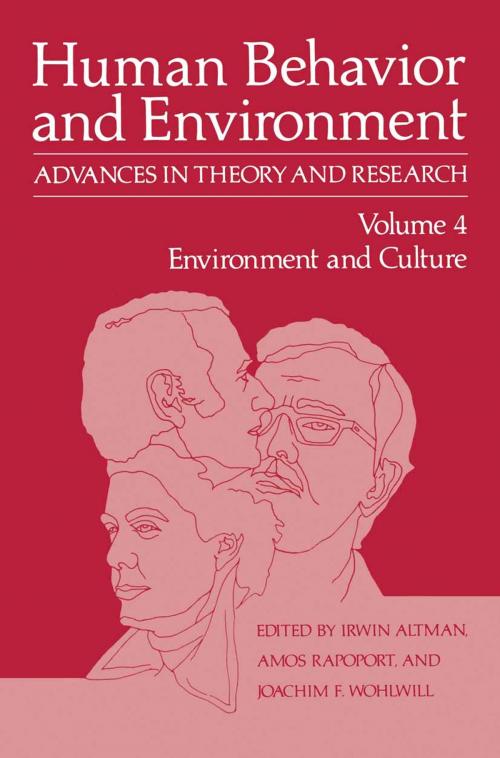| Author: | Anatol Rapoport | ISBN: | 9781489904515 |
| Publisher: | Springer US | Publication: | June 29, 2013 |
| Imprint: | Springer | Language: | English |
| Author: | Anatol Rapoport |
| ISBN: | 9781489904515 |
| Publisher: | Springer US |
| Publication: | June 29, 2013 |
| Imprint: | Springer |
| Language: | English |
Following upon the first two volumes in this series, which dealt with a broad spectrum of topics in the environment and behavior field, ranging from theoretical to applied, and including disciplinary, interdisciplinary, and professionally oriented approaches, we have chosen to devote sub sequent volumes to more specifically defined topics. Thus, Volume Three dealt with Children and the Environment, seen from the combined perspective of researchers in environmental and developmental psy chology. The present volume has a similarly topical coverage, dealing with the complex set of relationships between culture and the physical environment. It is broad and necessarily eclectic with respect to content, theory, methodology, and epistemological stance, and the contributors to it represent a wide variety of fields and disciplines, including psy chology, geography, anthropology, economics, and environmental de sign. We were fortunate to enlist the collaboration of Amos Rapoport in the organization and editing of this volume, as he brings to this task a particularly pertinent perspective that combines anthropology and ar chitecture. Volume Five of the series, presently in preparation, will cover the subject of behavioral science aspects of transportation. Irwin Altman Joachim F. Wohlwill ix Contents Introduction 1 CHAPTER 1 CROSS-CULTURAL ASPECTS OF ENVIRONMENTAL DESIGN AMOS RAPOPORT Introduction 7 Culture. . . . . . . . . . . . . . . . . 9 Environmental Design 10 The Relationship of Culture and Environmental Design . . . . . . . . . 15 The Variability of Culture-Environment Relations 19 Culture-Specific Environments . . . . . . . . . . . . . . . . . . . . . . . . . . . . . . . . 26 Designing for Culture. . . . . . . . . . . . . . . . . . . . . . . . . . . . . . . . . . . . . . . . 30 Implications for the Future . . . . . . . . . . . . . . . . . . . . . . . . . . . . . . . . . . . 39 References . . . . . . . . . . . . . . . . . . . . . . . . . . . . . . . . . . . . . . . . . . . . . . . . . . 42 CHAPTER 2 CROSS-CULTURAL RESEARCH METHODS: STRATEGIES, PROBLEMS, ApPLICATIONS RICHARD W.
Following upon the first two volumes in this series, which dealt with a broad spectrum of topics in the environment and behavior field, ranging from theoretical to applied, and including disciplinary, interdisciplinary, and professionally oriented approaches, we have chosen to devote sub sequent volumes to more specifically defined topics. Thus, Volume Three dealt with Children and the Environment, seen from the combined perspective of researchers in environmental and developmental psy chology. The present volume has a similarly topical coverage, dealing with the complex set of relationships between culture and the physical environment. It is broad and necessarily eclectic with respect to content, theory, methodology, and epistemological stance, and the contributors to it represent a wide variety of fields and disciplines, including psy chology, geography, anthropology, economics, and environmental de sign. We were fortunate to enlist the collaboration of Amos Rapoport in the organization and editing of this volume, as he brings to this task a particularly pertinent perspective that combines anthropology and ar chitecture. Volume Five of the series, presently in preparation, will cover the subject of behavioral science aspects of transportation. Irwin Altman Joachim F. Wohlwill ix Contents Introduction 1 CHAPTER 1 CROSS-CULTURAL ASPECTS OF ENVIRONMENTAL DESIGN AMOS RAPOPORT Introduction 7 Culture. . . . . . . . . . . . . . . . . 9 Environmental Design 10 The Relationship of Culture and Environmental Design . . . . . . . . . 15 The Variability of Culture-Environment Relations 19 Culture-Specific Environments . . . . . . . . . . . . . . . . . . . . . . . . . . . . . . . . 26 Designing for Culture. . . . . . . . . . . . . . . . . . . . . . . . . . . . . . . . . . . . . . . . 30 Implications for the Future . . . . . . . . . . . . . . . . . . . . . . . . . . . . . . . . . . . 39 References . . . . . . . . . . . . . . . . . . . . . . . . . . . . . . . . . . . . . . . . . . . . . . . . . . 42 CHAPTER 2 CROSS-CULTURAL RESEARCH METHODS: STRATEGIES, PROBLEMS, ApPLICATIONS RICHARD W.















